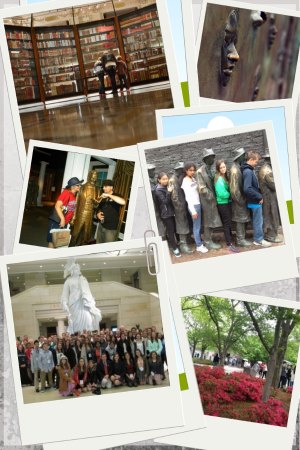New Washington D.C.
During the nineteenth century, Washington, D.C., the capital of the United States, was considered so unbearably warm and humid during the summer months that foreign diplomats received hardship pay for serving there. Now, the district holds a worldwide reputation as a cosmopolitan city rich in museums, monuments, and culture—and crackling with political power. From the hill where the U.S. Capitol sits, to Embassy Row, home to much of the foreign diplomatic corps in Washington, the wide avenues hum with the business of America.
Today, the Capitol Mall has become an evening spectacle. Our “monument illumination” activity includes visually stunning visits to the Jefferson, Lincoln, World War II Veterans, Marine Corps, Vietnam Wall and Korean War Veterans memorials. Our interpretative explanations of these marvelous icons reveal our passion for the principles, virtues, history, and sacrifice that they represent.
Famous places we visit in Washington D.C includes:
1) Library of Congress
The Library of Congress is the nation’s oldest federal cultural institution and serves as the research arm of Congress. It is also the largest library in the world, with millions of books, recordings, photographs, maps and manuscripts in its collections.
2) The Supreme Court
“The Republic endures and this is the symbol of its faith” – Chief Justice Charles Evans Hughes, 1932
This statement expresses the importance of the Supreme Court in the American system.
Interestingly the Supreme Court got its own building only in the 146th year of its existence in 1935. Before that the Court initially met in the Merchants Exchange Building in New York City. And when the National Capital moved to Philadelphia in 1790, the Court moved with it, establishing Chambers first in the State House (Independence Hall) and later in the City Hall.
When the Federal Government moved, in 1800, to the permanent Capital, Washington, the District of Columbia, the Court again moved with it, where the Congress lent the Court space in the new Capitol Building. The Court was to change its meeting place a half dozen times within the Capitol. And finally in 1929, Architect Cass Gilbert was charged by Chief Justice Taft to design “a building of dignity and importance suitable for its use as the permanent home of the Supreme Court of the United States.”
Architect Cass Gilbert designed the building in a classical Corinthian architectural style to create harmony with nearby congressional buildings. For more information about the Court Building you can click here.
3) Smithsonian Institution
Founded in 1846, the Smithsonian is the world’s largest museum and research complex, consisting of 19 museums and galleries, the National Zoological Park, and nine research facilities. Wow!! That’s huge. From Art to Zoo, the Smithsonian has something to interest kids and students of all ages.
4) National Air and Space Museum
The National Air and Space Museum (NASM) of the Smithsonian Institution holds the largest collection of historic aircraft and spacecraft and is a center for research into the history and science of aviation, spaceflight, planetary science, and terrestrial geology and geophysics. Almost all space and aircraft on display are originals or backups to the originals.
5) FDR Memorial in Washington D.C.
The Franklin Delano Roosevelt memorial is a presidential memorial dedicated to the memory of, yes you guessed right, U.S. President Franklin Delano Roosevelt.
The monument traces 12 years of the history of the United States. Sculptures depict the 32nd president, the Great Depression, listening to a fireside chat on the radio, waiting in a bread line, and many more. This is the only presidential memorial to depict a First Lady, in this case Eleanor Roosevelt.
Considering Roosevelt’s disability, the memorial’s designers intended to create a memorial that would be accessible to those with various physical impairments. Among other features, the memorial includes an area with tactile reliefs with Braille writing for people who are blind.
Fun Fact: The FDR Memorial on the National Mall is the second FDR Memorial in Washington, DC. The first one was built just the way Roosevelt wanted: a marble block no larger than his desk. The memorial stone stands on the northwest grounds of the National Archives Building, facing the U.S. Navy Memorial.
6) Vietnam Veterans Memorial
Honoring the men and women who served in the controversial Vietnam War, the Vietnam Veterans Memorial chronologically lists the names of more than 58,000 Americans who gave their lives in service to their country.
Fun Fact: Stone for the wall came from Bangalore, Karnataka, India, and was deliberately chosen because of its reflective quality. Stone cutting and fabrication was done in Barre, Vermont. Stones were then shipped to Memphis, Tennessee where the names were etched using a photoemulsion and sandblasting process.
7) Crime Museum
The Crime Museum is a privately owned museum dedicated to the history of criminology and penology in the United States and provides guests of all ages with memorable insight into our nation’s history of crime and its consequences, law enforcement, forensic science, and crime scene investigation through a captivating, interactive, entertaining, and educational experience.
8) Ford’s Theatre
Ford’s Theatre is a historic theatre in Washington, D.C., used for various stage performances beginning in the 1860s and is the site of the assassination of U.S. President Abraham Lincoln on April 14, 1865.It was renovated and re-opened as a theatre in 1968. It was renovated again in the 2000s and opened on February 12, 2009, in commemoration of Lincoln’s bicentennial.
With the opening of the Center for Education and Leadership, Ford’s Theatre has become a major center for learning, where people of all ages can examine Lincoln’s multi-faceted Legacy through exhibits, workshops, seminars and speakers as well as community outreach programs.

